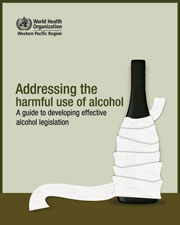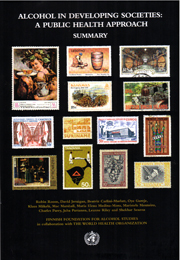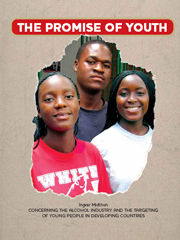
Alcohol Control in Nepal: Challenges and Opportunities
The alcohol question in Nepal has been put to the extreme the last few months, with the maoist womens movement demanding a total ban on alcohol nation wide. This has lead to a negotiated settlement focusing on alcohol control. In this article the contact person in CWIN for the Local Action against Alcohol and Drugs project, Rupa Dhital, is focusing on alcohol control in Nepal.
Talking about alcohol control in Nepal is not a straightforward black and white issue. Alcohol consumption is associated to people since the time immemorable. It has deep-rooted religious, cultural and traditional dimensions, as well as social, economic and political implications.
Two competing perspectives exist in dealing with the alcohol issue in development literature. One perspective views alcohol through health concerns. The WHO is the yardstick in this perspective. The overall notion is to control the use of alcohol since it reduces the longevity of human life. Societies particularly those adhering to Protestant in America, Muslims everywhere, and Hindus in South Asia have such views about alcohol. They view that alcohol should be stigmatized as a drug and discouraged its use as strongly as possible. However, WHO in its recent report suggested that approaches to alcohol must be consistent with local cultures and mores. Each country must develop its own unique mix of strategies. Increased attention to alcohol and a commitment to implementing comprehensive programmes of education, treatment and regulation will help to reduce and avert an epidemic of alcohol-related disability, diseases and death worldwide (WHO, 1999).
Alternative perspective
Another perspective views alcohol as culture and lives. Hanson, an American Sociologist, and Heath, an American Anthropologist, are in the view that alcohol encourages undesired consequences in the society such as black-market, violence, and other social crimes. Control can not be achieved in a real sense. Their notion is to regulate the use of alcohol. Furthermore, they regard alcohol use in a continuum from the most harmful to the normal and sometimes beneficial one.
Heath (1990) emphasizes the need to take into account a wide variety of social, psychological, and physical benefits of moderate drinking that have been long recognized cross-culturally. He explains that the nature of problems that are associated with alcohol is a matter of social construction, negotiated differently by various constituencies, at various times. Putting problem drinkers and moderate drinkers in the same category is one mistake social scientists make and its implication is that it shall take away the focus from studying harmful drinking behaviour closely.
Previous studies from Nepal were mainly directed towards prohibition approach with little attention to the cultural, religious and social values of alcohol in Nepal. They mostly relate alcohol use with the social crime and violence against women and children. Subba et al. (1995) have analysed alcohol and drug use in the socio-cultural and political perspective of the indigenous people in Nepal who belong to traditional alcohol-user groups. This perspective associates alcohol and drug abuse and related delinquencies and deviant behaviour to poverty, deprivation, low level of education, social injustice, social isolation and cultural discrimination that are faced by people from ethnic groups who differ from the mainstream of dominant culture. The alcohol and drug prevention effort in such a scenario should be made in the context of empowerment of the backward communities, their representation in the decision making, due share in the countrys resources, education and information in their language. A thorough understanding of the socio-cultural characteristics and psychographics of people should be established in order to design culturally appropriate programme for alcohol and drug prevention.
Need for holistic approach
For the effective control of alcohol in a society, a holistic approach is required that adequately addresses the social, economic, cultural, traditional and other realities. For a change to occur in a society, there has to be a healthy balance between policies and infrastructures, between law implementation and socio-cultural aspirations of people. Ultimately, alcohol control is more a matter of attitude change than anything else which can be accelerated with realistic regulations, adequate education and empowerment of people.
In the changing scenario of Nepal, when the Home Ministry has conceded to much of the demands put forth by the All Nepal Womens Association (Krantikari), some strong preventive measures against production, distribution and consumption of alcohol are soon to be implemented:
- Prohibition of drinking under the age of 25 and selling under the age of 21
- Allowing only a certain number of outlets selling liquor - four shops in each ward of metropolitan cities, three shops in sub-metropolitan, and only two shops at the village level
- Limited hours for alcohol sale - from 2- 6 PM
- Banning the distillation of liquors from food grains
- Sale of alcohol not allowed within 300 meters (in urban areas) and 500 meters (in rural areas) from religious and educational institutions
- Blanket ban on alcohol advertisements in the media
- Announcement of no-liquor day on the first, second day and the last two Saturdays of every month (pay days and holidays).
- Not issuing new licenses for producing alcohol and regulating the existing ones and diverting them to produce other things
- Necessary law reformation in order to implement the new agreements
In addition to that there are a few other agreements such as investing a part of alcohol profit on womens education and environment preservation. These decisions are supposed to be imposed within 15 days of issue by the Home Ministry (August 25) for those which do not require any change on the existing laws and policies. And the decisions which require changes in the laws are to be effective by 1 October.
It is a revolutionary statement agreed by the government in the line of alcohol regulation rather than prohibition. This decision has been taken in the special political climate of the country where government is trying to introduce other social reforms also. In such a scenario, it is perhaps easy to commit but it will be a hard act to follow unless the necessary infrastructures are built. It is a positive news for those concerned with the control of alcohol but panic statement for others, specially the alcohol industry and related businesses such as retailers and restaurants.
To look at the few key issues that emerge out of this government decision:
National Revenue
It is argued strongly that alcohol industry generated much revenue for the nation and its collapse will mean a significant economic deterioration. It is largely true but not the absolute truth because there has to be an alternative to alcohol money. It is actually a myth that alcohol and tobacco industry is necessary to sustain our economy. There are so many other areas where there are leakages in revenue collection due to corruption and tax exemptions. Other alternatives should be explored to compensate the loss of alcohol income. It is a matter more of a good governance in creating a just society rather than defending the industry in the name of profit. The commercialisation of alcohol is the crux of the problem rather than the traditional practices.
Alcohol Industry and Employment Situation
The problem is that we have had such a conducive socio-political environment for investment on alcohol, and this has to be discouraged. Other industry should be given incentives to come up, the new industry for alcohol registration should be stopped and alternatives to be explored for the employment situation. Alcohol investment should not be allowed to be so lucrative with huge profit margins. The media ban on alcohol advertisement is absolutely a commendable step.
Restriction on Sale and Consumption
Nepal is perhaps the only country in the world where liquor is available at any time, any place, to any age group without any restriction whatsoever. Its absolutely necessary for social security and to protect our children that there is restriction in sale, distribution and consumption of alcohol. It has been proved that control on three As: Accessibility, Availability and Affordability will automatically bring down the consumption volume.
Import of Alcohol
This is one point where the government could not agree on banning of import while the womens association is for it and demanding investment to develop national technology to produce high quality liquor inside the country. Because of the growing free market and globalisation, ban on import seems improbable. Maybe the imports could be levied steep taxes with the that assumption that high price means low sale.
Womens Movement vs. National Movement
In Nepal, anti-alcohol movements have been essentially womens movements. Arguably it is the women who suffer the brunt of alcohol related social and familial problems, but for the movement to be successful it is very necessary for men to take part equally. In a patriarchal society like ours where men have more access to decision making, it is important that the movement is not gender segregated. Alcohol control should be a national issue rather than a feminist concern.
Prohibition vs. Regulation
The complete prohibition effort has not worked in most societies. The lessons from many countries shows that prohibition had led to black marketeering, bootlegging and other organised crimes. In Nepal also, the dry-zone movements have given rise to some of such unwanted results and they have not been sustainable. The social and cultural reality of our country also does not allow total alcohol ban unlike in prohibitive societies like Muslim countries. Restriction and regulation of access and availability of alcohol in the market is the answer, as is the social system for discouragement of sale and consumption.
Finally, alcohol is so related to peoples life in its social and cultural context. The challenge is how to handle the demand side. It is important to discourage alcohol consumption in the society. And it is not an easy task. In a rapidly changing world with colliding values, isolation of people and so many other influences, alcohol is being accepted more and more. The global alcohol market is powerful and it has targeted younger and younger people into initiating drinking. On the other hand, we have this very strong reality where alcohol is closely embedded into the social, cultural and religious life. Therefore, it is very important to analyse the conditions that play catalytic role in peoples attraction and addiction to alcohol. There needs to be an effort to look at the ways of taking away some of the pressure to drink. The challenge is giving people alternatives, to establish alcohol-free lifestyles as healthy and desirable as opposed to the cool images sold by the alcohol industry that prompt drinking. Even in the ritualistic and cultural use of alcohol, there is always the possibility of restrain and doing with less.
In order for the alcohol restriction to be successful, proper mechanisms need to be worked out at the policy level for implementation and monitoring. A national consensus has to be built in order to breathe legitimacy into this important social measure. For the movement to be sustainable, however, it is up to the civil society, the organisations, people and communities who are the real bearers of change. And such change is possible not by force but by conviction only.
Rupa Dhital is the Local Contact person for the Local Action against Alcohol and Drugs project in Nepal. She has been responsible for the study: Alcohol & Drug Use in Nepal: with reference to children, published in May 2001, CWIN, Kathmandu.
![]()
![]()
Developed with CustomPublish CMS by Nettinfo AS




